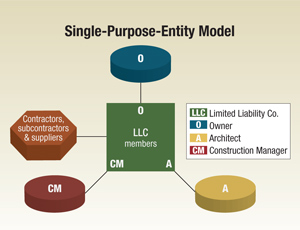Some American Institute of Architects’ 2008 model contract documents for integrated project delivery are being challenged by at least one prominent lawyer who also is an architect and general counsel for a major A/E firm. The documents create a limited-liability company called a single-purpose entity (SPE). Do not use these model documents without “competent legal counsel review,” because they are “flawed,” says Bill Quatman, managing director for Burns & McDonnell Engineering Co., Kansas City.


The so-called flaws in AIA’s SPE family of documents relate to issues of indemnity, mutual waivers of claims and insurance, says Quatman. He also takes issue with the makeup of the SPE’s governance board, not only because it guarantees the owner majority control, but because it may violate licensing law in some states.
AIA’s documents committee does “great work and puts out the best documents, but this is a whole new concept,” said Quatman, speaking at an IPD session at the AIA Convention 2009, in San Francisco on April 30-May 2. “AIA should not put out a document that mandates you have a lawyer to fix it; it should be able to be used off the rack,” he said.
Kenneth Cobleigh, AIA counsel, disagrees with Quatman. “I don’t believe the documents are flawed. We believe they meet the needs [of architects] and are generally enforceable. We recognize jurisdictions might require modifications” to them, he says.
At the convention, which had 21,500 registrants, AIA released replacement construction-manager documents and an updated version of AIA Contracts Documents software. The software is more user-friendly and responsive, allowing users to view, edit, share and manage documents using one tool, said AIA.
The CM documents cover the CM as adviser and CM as constructor. The release incorporates concepts from general AIA Contract Documents, including a dispute-resolution check box and an initial decision-maker selection option.
In the CM as adviser, “we tried to really make clear the duties of the architect and CM over the course of the project,” says Cobleigh. The architect retains final say over the interpretation of the contract documents and has responsibility for final approval of the pay applications. Three duties exclusive to the CM are to develop a CM plan, develop monthly project reports, and maintain the project documents on-site.
Also at the convention, AIA and the AIA California Council released its second guide to IPD, “Experiences in Collaboration: On the Path to IPD.” The 18-page guide highlights IPD lessons learned from 32 participants in a symposium organized by the council. The first guide, “IPD: A Working Definition,” was published in 2007. It forms the basis of the AIA’s IPD documents.
The new guide discusses, from participants’ experiences, the value proposition of IPD and how to build a team. “The journey to IPD is a long one,” concludes the guide.
There is guidance for determining and managing the budget and IPD contract language. “IPD principles can be applied to a variety of contractual arrangements,” says the guide.
AIA’s SPE contractual arrangement (C195-2008), released last May, creates an LLC. Members of the LLC are the owner, architect, construction manager and perhaps other key project participants. The LLC, funded by the owner, is created for the purpose of planning, designing, constructing and commissioning a project, says AIA. The architect and CM share in the project’s risk and reward. The architect gets paid its direct costs. If the project comes in below the target cost, SPE members share in the profits.
COUNSEL, BURNS & AMP; McDONNELL
Last fall, AIA released the standard form of agreement between the SPE and the owner (C196-2008) and the SPE and non-owner member (C197-2008).
Cobleigh calls IPD a cutting-edge concept because it is a delivery model that advocates a high degree of collaboration among project participants, has new and novel approaches to project compensation, changes attitudes regarding disputes and claims resolution and seems to foster trust and a high degree of interaction among parties. He says AIA has no plans to pull the SPE models off the market and no set timetable to revise them. “We knew they would be thought-provoking and are soliciting comments,” says Cobleigh.
Under C195, “members [of the LLC] waive claims against the company and against other members, except for willful misconduct; the company exculpates and indemnifies its members on the same basis,” says AIA’s guide.
Despite the representation, there is no full waiver of claims, Quatman says. He also notes there is no LLC insurance available to protect the architect and the indemnity clause violates most state anti-indemnity statutes. The reimbursement of the architect’s deductible would be frowned on by most insurance carriers, he adds. “Some of the clauses are illegal in some states and generally unenforceable and impractical,” says Quatman.
Zigmund Rubel, principal of Anshen + Allen Architects, San Francisco, and a member of the IPD steering committee of the AIA California Council, says, “I agree with Bill Quatman’s concerns...



Post a comment to this article
Report Abusive Comment